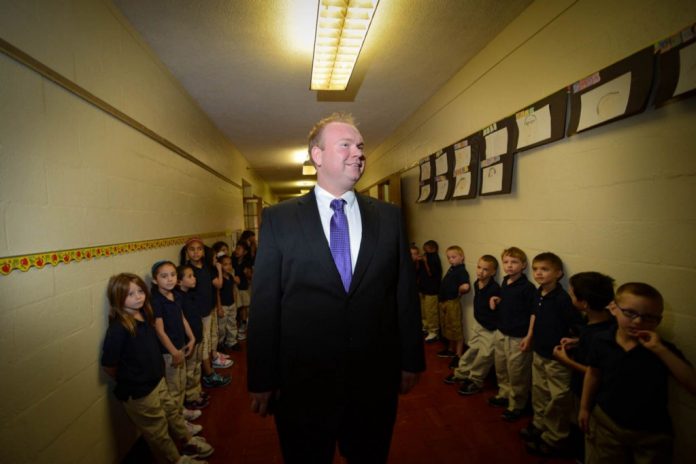Guy Lowery might look young enough to be a college undergraduate, but he subscribes to some old-school theories on education.
As the new principal at the Mayfair School, the 30-year-old Lowery plans to put a new emphasis on core subjects, small-group instruction and firm but fair discipline to improve student performance at the Northeast-based grade school.
“We did not make AYP last year,” said Lowery, referencing the school’s failure during the 2011–12 academic year to achieve “adequate yearly progress” as defined by the federal No Child Left Behind Act.
“So coming into this situation, [knowing] we have a lot of dedicated staff members, it’s upsetting when you go into meetings and have to say we didn’t make it last year,” he said. “[The teachers] want to make academic progress. They’ve been willing to listen to new ideas. They are willing to change.”
Lowery believes he’s learned a lot about teaching and administration in his relatively brief career.
As a child, he attended Clara Barton Elementary and Central East Middle schools in Feltonville. Then his family moved to Mayfair and he attended Northeast High, graduating in 2000.
The school district hired him in 2004 to teach science at Austin Meehan Middle School. He later became chairman of the special education department at Meehan, then served two years as an assistant principal there.
The principal’s job opened at Mayfair last summer when Roberta Besden retired and the school’s former assistant principal, Tony Wilson, transferred. Former Thomas Creighton School assistant principal Eugene Golson replaced Wilson.
Mayfair School, at 3001 Princeton Ave., serves about 1,100 pupils in kindergarten through eighth grade. The school draws students from a geographic area bordered by Roosevelt Boulevard, Sandyford Road, Ryan Avenue, Frankford Avenue and Unruh Avenue.
Relatively stable but stagnant academic performance, along with steady enrollment growth and ethnic diversity, have marked its recent history.
According to the School District of Philadelphia, the official enrollment was 1,044 students last academic year, 991 in 2010–11 and 921 in 2009–10. More than half of the students (53.1 percent) were classified as “white” last year, while 14.5 percent were “Asian,” 13.9 percent “Latino” and 12.1 percent “African-American.”
Almost two-thirds of students (62.3 percent) were “economically disadvantaged,” according to school district figures, while 12.2 percent did not speak English as their first language.
During the school year, 82 students withdrew from the school, but 96 new students arrived. In practical terms, exact enrollment is always in flux.
“The Northeast as a whole is exploding at the seams. It’s not just my school,” Lowery said. “A lot of people are moving up into the Northeast and a lot of families are buying homes in the Northeast. They send their children here, which is a good thing.”
The school district has turned to modular classrooms — commonly known as “trailers” — to accommodate enrollment growth at Mayfair. The two-story school has four trailers on its campus, which is contiguous with the Mayfair Community Center and a city playground.
Younger grades use the trailers in addition to their standard classrooms on the first floor of the main building. Older grades stay mostly on the second floor, although they go downstairs for lunch periods.
On standardized tests, Mayfair students have scored well compared to other public schools in the city, but they’ve performed poorly in comparison with the rest of Pennsylvania and within the context of AYP.
The state’s Department of Education released test results from the 2011–12 academic year in September. In math, 73.7 percent of Mayfair students scored at a “proficient” level or above, while 61.8 percent were proficient or better at reading. Those figures placed the school in the bottom 23 percent of public grade schools statewide. In 2010–11, the results were slightly better, although the school placed lower (in the bottom 18 percent) statewide.
Mayfair reached its math proficiency peak of 84.2 percent in 2005–06. The following year, it reached its peak on the reading portion with 67.7 percent proficiency.
Based on last year’s test scores, the Web site schooldigger.com ranks Mayfair as 1,247th out of 1,606 public elementary schools in Pennsylvania.
Lowery thinks teachers should have more time with students individually and in small groups.
“We want to work smarter, really want to start drilling down to individual children,” the principal said.
“The most important thing is to make a connection with kids. Then they respect you, they have a rapport with you.”
Lowery estimates the school’s teaching faculty at about 70, which would make for a student-teacher ratio of about 16:1. The ratio was about 20:1 last year and about 18:1 the previous year, according to schooldigger.com.
“The school district has provided staff members to meet the increase in enrollment,” Lowery said.
That includes non-teaching staff. The school has added two “noontime” aides to monitor safety in the modular classrooms. But Mayfair is not considered a dangerous school by city or state standards.
There were five “serious incidents” (two assaults and three weapons cases) reported there in 2010–11, along with 24 student suspensions. Totals for last school year were unavailable from the school district.
“Even though we’re not at that [dangerous] stage, we have strong systems in place to ensure that eleven-hundred kids can move around the building,” Lowery said.
The principal’s mission is to maintain and promote the school as a place where Mayfair residents feel comfortable sending their children.
“It’s a school with a lot of pride [among] a lot of staff and students,” he said. ••
Reporter William Kenny can be reached at 215–354–3031 or [email protected]





